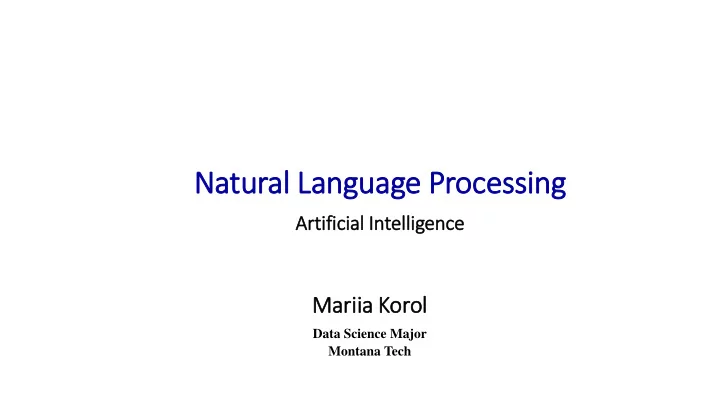

Natural Language Processing Art rtif ific icia ial l In Intell llig igence Marii iia Korol Data Science Major Montana Tech
Outline
What is NLP? Data Science Computer Science NLP (Natural Language Processing) computers dealing with language Linguistics
Turing Test History flash back of NLP : Test of Alan Turing in 1950s Can a human distinguish between texting with another human and a computer program?
Applications of f NLP • Language translation applications such as Google Translate • Word Processors such as Microsoft Word and Grammarly that employ NLP to check grammatical accuracy of texts. • Interactive Voice Response ( IVR ) applications used in call centers to respond to certain users’ requests. • Personal assistant applications such as OK Google, Siri, Cortana , and Alexa .
Applications of f NLP • Statistical text/document analysis : classification, clustering, search for similarities, language detection, etc • Capturing syntactic information : part-of-speech tagging, chunking, parcing, etc. • Captuting semantic information (meaning) : word-sense disambiguation, semantic role labelling, named entity extraction, etc . The presentation concentrates on text similarity search and text clustering
Approaches to to NLP Rule Based Approach Statistical Approach • Harcoded rules based on some • Statistical algorithm which search knowledge patterns and rules • Simple • Flexible • Robust • Generic • Not flexible • Complex
Text xt Cla lassification and Sim imilarity • Finding similar texts by content • Assigning texts to predefined • categories • Finding clusters of texts by content What is needed? • Represent the texts in computer readable format (numbers) • Run statistical algorithms for these texts
Bag of f Words Alg lgorithms The order and the meaning of the words do not matter
TF – ID IDF Algorithm TF: Term Frequency Transform texts into numeric vectors, where each unique word is a separate dimension Text 1: Hi, world Text 2: Hello, world Coordinate phase space: Hi, Hello, World Text 1: (1, 0, 1) Text 2: (0, 1, 1)
TF – ID IDF Algorithm TF: Term Frequency Transform texts into numeric vectors, where each unique word is a separate dimension Text 1: Hi, world Text 2: Hello, world Coordinate phase space: Hi, Hello, World Text 1: (1, 0, 1) Text 2: (0, 1, 1) Zipf's law: 𝑔 ∼ 𝑠 𝛽
TF – ID IDF Algorithm TF: Term Frequency TF: Term Frequency Transform texts into numeric vectors, where each unique word is a separate dimension Text 1: Hi, world Text 2: Hello, world Coordinate phase space: Hi, Hello, World Text 1: (1, 0, 1) Text 2: (0, 1, 1) Term Frequency Zipf's law: 𝑔 ∼ 𝑠 𝛽 relevancy of a word to a document Document Frequency
TF – ID IDF Algorithm TF: Term Frequency Transform texts into numeric vectors, where each unique word is a separate dimension Text 1: Hi, world Text 2: Hello, world Coordinate phase space: Hi, Hello, World Text 1: (1, 0, 1) Text 2: (0, 1, 1) IDF: Inverse Document Frequency Penalize words which are frequent but don't have any meaning: a, the, is, etc. Total number of texts Each TF coordinate is multiplied with a weight Number of texts in which a certain word appears
Cosine Similarity Are the texts similar? Look at the angle between the vectors Text 1: Hi, world If vectors are collinear – texts are similar Text 2: Hello, world If vectors are orthogonal – texts are different Measure – cosine Orthogonal. But similar! Hello and Hi different words but same meaning!
Cosine Similarity (𝑈𝐺𝐽𝐸𝐺1⋅𝑈𝐺𝐽𝐸𝐺2) Text 1: (1, 0, 1) cos(𝑈𝐺𝐽𝐸𝐺1, 𝑈𝐺𝐽𝐸𝐺2) = ∥𝑈𝐺𝐽𝐸𝐺1∥⋅∥𝑈𝐺𝐽𝐸𝐺2∥ Text 2: (0, 1, 1) (𝑈𝐺𝐽𝐸𝐺1 ⋅ 𝑈𝐺𝐽𝐸𝐺2) = ∑𝑈𝐺𝐽𝐸𝐺1 𝑗 ⋅ 𝑈𝐺𝐽𝐸𝐺2 𝑗 [1, 0, 1] * [ 0, 1, 1 ] 𝑈 2 sqrt(1+0+1) * sqrt(0+1+1) ∥ 𝑈𝐺𝐽𝐸𝐺1(2) ∥= 𝑈𝐺𝐽𝐸𝐺1(2) 𝑗 𝑗
Soft Cosine Similarity ∑ 𝑡 𝑗𝑘 𝑏 𝑗 𝑐 𝑘 𝑗,𝑘 cos 𝑡𝑝𝑔𝑢 (𝑏 , 𝑐) = ∑ ∑ 𝑡 𝑗𝑘 𝑏 𝑗 𝑏 𝑘 ⋅ 𝑡 𝑗𝑘 𝑐 𝑗 𝑐 𝑘 𝑗,𝑘 𝑗,𝑘
Clustering of f Texts xts How to Cluster Texts by Topic? • Represent texts in IT-IDF vectors • Set a threshold of similarity on soft cosine similarity measure • Select groups of texts which are similar within the selected threshold Or make use of Clustering
K Means Clustering Basic K-Means Algorithm Choose k number of clusters to be Determined. Choose k objects randomly as the initial cluster center Repeat Assign each object to their closest cluster Compute new clusters (calculate mean points) Until No changes on cluster centers (centroids do not change location any more) OR No object changes its cluster
K Means Clustering Base – TF-IDF vectors The overall distance to geometrical centers of the clusters is minimized
Summary ry • NLP – very wide field which combines computer science, linguistics and data science • NLP finds its applications in every field where language is applied in any form • This work was concentrated on text similarity search and text clusterind • IT-IDF algortihm can represent texts in form of numeric vectors • Soft cosine similarity is an intuitive but efficient method to find similarity between texts • Any clustering algorithm can be applied upon IT-IDF vectors. One of the most simplest, but widely used algorithms is K Means clustering
References Deokar, S. T. (2013). Text Documents clustering using K Means Algorithm. International Journal of Technology and Engineering Science, 1(4), 282 – 286. Retrieved from https://pdfs.semanticscholar.org/4a43/dc3e76082aef3c1fa920b5d023dbf2cb3571.pdf Garbade, M. J. (2018, October 15). A Simple Introduction to Natural Language Processing. Retrieved from https://becominghuman.ai/a-simple-introduction-to-natural-language-processing- ea66a1747b32 Yu, S., Xu, C., & Liu, H. (2018). Zipf's law in 50 languages: its structural pattern, linguistic interpretation, and cognitive e motivation. Retrieved from https://arxiv.org/abs/1807.01855 Machinelearningplus.com. (2018, October 30). Cosine Similarity - Understanding the math and how it works? (with python). Retrieved from https://www.machinelearningplus.com/nlp/cosine- similarity/. Wang, Y.X. (2019, January 29). Artificial Intelligence. Retrieved from https://sites.cs.ucsb.edu/
Recommend
More recommend